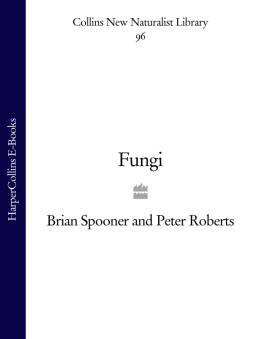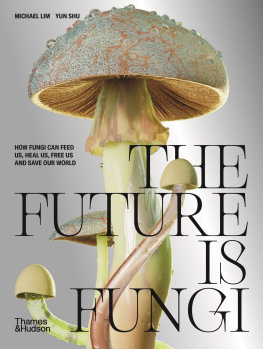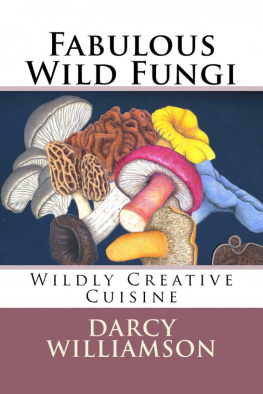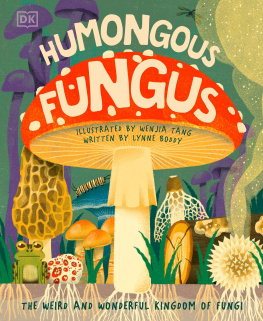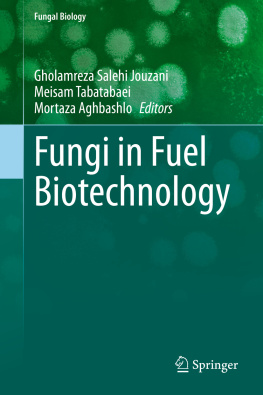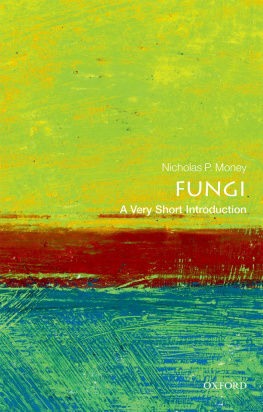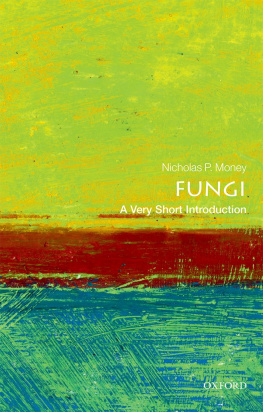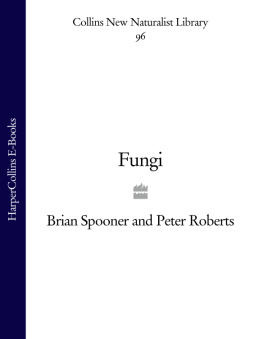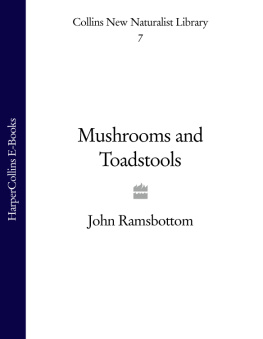SARAH A. CORBET, ScD
S.M.WALTERS, ScD, VMH
PROF. RICHARD WEST, ScD, FRS, FGS
DAVID STREETER, FIBIOL
DEREK A. RATCLIFFE
The aim of this series is to interest the general reader in the wildlife
of Britain by recapturing the enquiring spirit of the old naturalists.
The editors believe that the natural pride of the British public
in the native flora, fauna and fungi, to which must be added
concern for their conservation, is best fostered
by maintaining a high standard of accuracy
combined with clarity of exposition
in presenting the results
of modern scientific
research.
I T IS NOW more than 50 years since John Ramsbottoms Mushrooms and Toadstools first appeared as Volume 7 in the New Naturalist series. It fast became one of the most prominent of the early titles, running to a total of six impressions before finally going out of print in 1983. The Editors have long planned a successor which would present an up-to-date account of fungal natural history that took into account all the developments in the subject over the past half-century. Thus it is with particular satisfaction that we welcome Fungi as Volume 96, written by two of the countrys leading mycologists.
Brian Spooner is Head of Mycology at the Royal Botanic Gardens, Kew, where he has worked since 1975, and is an authority on the British Ascomycetes. Peter Roberts also works at Kew as a Senior Mycologist with a particular interest in the non-agaricoid Basidiomycetes.
In 1953, the Editors wrote in the preface to Mushrooms and Toadstools, Dr. Ramsbottom could undoubtedly have written in fact, did, in the first place, write a book more than double the present length; and even then, he complained that much had to be omitted! Honesty compels us to record that the present authors had to be no less curtailed and no doubt harbour a similar grumble about the Editors! It is now generally accepted that the original view that the living world could be conveniently divided into plants and animals, albeit with the bacteria constituting an awkward anomaly, is no longer adequate to describe the diversity of the planet. The fungi are now recognised as a separate Kingdom of their own, but back in the early 1950s, this view was only just beginning to be universally accepted. Indeed, one of the questions that John Ramsbottom rather coyly skirted around was What is a fungus?.
Fungi contain some of the most beautiful, bizarre and grotesque products of evolution on the planet. Among them can be found some of the largest and long-lived organisms on earth. There is probably no corner of the globe that is without them. Most importantly, they form intimate associations with other organisms, enabling them to live in conditions from which they would otherwise be excluded. The partnerships between fungi and green algae, or cyanobacteria, that produce lichens are well known, but it is now recognised that, among the higher plants, those without a fungal partner are the exception rather than the rule. Indeed, it may well be that the invasion of the land itself was crucially facilitated by the evolution of these plant-fungal partnerships. Finally, fungi touch our own lives as causers of crop diseases and, more positively, from the yeast that provides our daily bread to the antibiotics on which modern medicine depends. Some of these aspects have already been covered in recent New Naturalist volumes such as David Ingrams and Noel Robertsons Plant Disease (85) and Oliver Gilberts Lichens (86), but for the rest, we confidently leave the reader to discover in the following pages.
I T IS NOW more than half a century since John Ramsbottoms classic Mushrooms and Toadstools was published in the New Naturalist series. It was the first of the series to deal with fungi and contained a wealth of information, focused particularly on the development of mycology and the ecology of fungi, which helped bring both subjects to the wider audience they deserve.
The succeeding 50 years has seen immense progress in the study of fungi, establishing even more firmly the major role they play in the environment and in our day-to-day lives, and highlighting the extraordinary diversity of these ancient and ubiquitous organisms. Gone are the days when fungi were treated as an obscure subset of lower plants studied mainly as unwanted causers of disease. They are now understood to form intimate and beneficial partnerships with almost every form of life, from bacteria and algae to flowering plants, insects and even mammals, while also providing the vital service of decay, decomposition and nutrient recycling on which all terrestrial life depends.
So integral are fungi to the health and wealth of mankind that nobody can escape their influence even on a daily basis. It is true we still suffer the unwanted effects of fungal decay from moulds and crop diseases to dry rot and athletes foot but increasingly we are discovering the many and varied benefits of fungi, in new and traditional foods and drinks, in pharmaceuticals, in forest and agricultural management, in biological pest-control and in the bioremediation of oil spills and waste pollution.
The fungi themselves have finally been recognised as forming their own kingdom distinct from animals and plants. It is no small kingdom either. The mushrooms and toadstools of Ramsbottoms book, as diverse and numerous as they are, are just a small part of the vast assemblage of fungi, probably amounting to well over a million species worldwide, the majority of which remain as yet undescribed and still unknown to science.
It is clearly impossible to cover all aspects of modern mycology in a single volume, and our aims have therefore been to look at the ecology and influence of fungi, to give some idea of their diversity and importance, and to outline their main characteristics. A lot more could be said about their structure, biology and physiology, but these topics are already well covered in student and academic texts. A lot more could also be said about recognising and identifying fungi in the field but, fortunately, todays forayers can choose from a wide selection of well-illustrated field guides an indication of the growing popularity of fungi as a worthwhile subject to explore. We hope this new book will be a complementary volume to such field guides, giving the interested naturalist a few extra insights into what is going on behind the scenes in the fungal world.
The writing of this work has proved to be a far longer and more involved exercise than was originally envisaged, and we owe considerable thanks to our publishers for their patience in allowing it to develop over several more years than were initially planned. It has also been the source of endless surprise and learning, with many of the subjects covered proving far more complex and far-reaching than we ever imagined, leading us not only into byways but also some major highways of research of which we previously knew little. Keeping up with the constant flow of new papers, new discoveries and information has also been a challenge, albeit an exciting one, and we have tried our best to keep pace. We would like to acknowledge all the mycologists and other researchers who, through their many and various papers and books, have unwittingly helped us create this book. Our initial hope was to list all our sources and references, but when the working bibliography started heading for the 100-page mark, common-sense (and our publishers) dictated a substantial cut-back. The references that remain will, we hope, still be of use for exploring many topics further.
It is a big book, but the kingdom of the fungi is an even bigger subject. We trust that you may find at least a few new, interesting, remarkable and entertaining things inside.
The broad scope of the book has required an equally broad search for photographs and images to illustrate the many different kinds of fungi involved. The authors are indebted to the following generous individuals, who responded so promptly and positively to our requests for help in sourcing illustrations, and for kindly giving permission to use their photographs and images. Additional thanks are due to Paul Bridge and Julian Mitchell and also to Lynton Mclain who supplied further information on some specialist topics.

